Kia Sorento
Camshaft Position Sensor Replacement Guide
How to change the camshaft position
sensor (CPS) in a 3rd generation 2016 to 2020 Kia Sorento with the 3.3L V6
engine.
By Paul B. Michaels Author & Photographer Auto Mechanic Since 1989 |
||
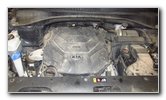 2019 Sorento 3.3L V6 |
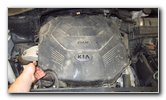 Lift Front of Cover |
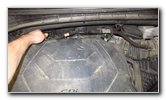 Lift Rear of Cover |
|
This automotive maintenance tutorial was specifically written to assist owners of the third generation (2016, 2017, 2018, 2019 and 2020) Kia Sorento SUV in changing a failing or faulty camshaft position sensor (or "CPS") on the Lambda II GDI 3.3L V6 engine. The procedure may be similar for the Theta II GDI 2.4L I4 engine and also the Theta II Turbocharged GDI 2.0L I4 engine. A few of the symptoms of a failing or faulty camshaft position sensor include the following: rough idling, stalling, a loss of power, reduced fuel economy (lower MPG), slow acceleration, difficulty starting, jerking, surging and a CEL / SES (check engine light / service engine soon) warning light on the dashboard. If you have an OBDII Scanner (also known as an OBD2 Scan Tool), some of the camshaft position sensor related DTC (diagnostic trouble codes) that you might see include the following: P0340 - camshaft position sensor circuit malfunction, P0341 - CPS circuit range / performance issue, P0342 - CPS circuit low input, P0343 - CPS high input, P0344 - CPS circuit intermittent, P0345 - CPS sensor A circuit malfunction and P0390 - CPS B bank circuit malfunction Owners of other Kia, Hyundai and Genesis vehicles such as the Soul, Seltos, Sportage, Niro, Telluride, Forte, Rio, Optima, Stinger, Cadenza, K900, Sedona, Kona, Venue, Santa Fe, Elantra, Sonata, Accent, Veloster, Ioniq, Nexo, G70, G80 and G90 may also find these instructions to be helpful. The OEM (original equipment manufacturer) part number in this 2019 Sorento was Kia 39318-3L000 (also known as part number Kia 39318-3C500). A few other compatible replacement camshaft position sensors with their part number are as follows: Beck/Arnley 1800779 (or 180-0779), Standard Motor Products PC946 and Holstein Parts 2CAM0360. Please check the part number on your old sensors before purchasing a new one. The tools needed to remove and replace the sensor include a 10mm socket and a 1/4" drive ratchet. The first two steps are to open the hood and then carefully pull off the black plastic engine cover. |
||
|
|
||
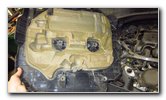 Engine Cover Removed |
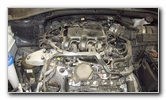 Lambda II GDI 3.3L V6 |
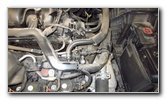 Front Right Corner |
| The engine cover is
held in place by four rubber friction fasteners attached to metal pegs on
the top of the intake manifold and the valve cover.
Set the plastic engine cover aside in a safe place. One of the two camshaft position sensors is situated on the right (driver) side of the engine near the front corner. The other identical sensor is situated further back on the engine about 12" past the front sensor and close to the rubber air intake hose. |
||
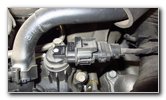 Camshaft Position Sensor |
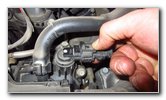 Push In Release Tab |
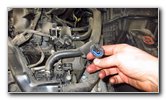 Slide Off Power Plug |
| Push in the release tab on the electrical connector before sliding it straight off the base of the old sensor. | ||
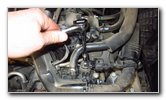 Loosen Counterclockwise |
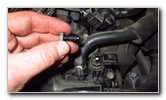 Black Metal Bolt Removed |
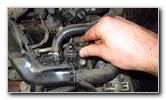 Rotate Back & Forth |
| Loosen the single
black metal bolt on the top of the old sensor by rotating it in the
counterclockwise direction with the 10mm socket and a 1/4" drive ratchet. Spin out the bolt the last few turns by hand to prevent from having it fall down into the engine bay and become lost. Set the bolt aside in a safe place. Gently rotate the old sensor back and forth a few times to help loosen the rubber o-ring gasket from the housing. |
||
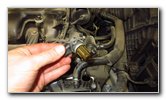 Remove Old Sensor |
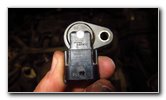 Old CPS Sensor |
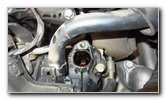 Sensor Port / Housing |
| Carefully pull the
old sensor straight out of the engine. The OEM (original equipment manufacturer) sensor was marked as part number 39318-3L000 4C84220Y 9024170001 185328. For this 2019 Sorento with the Lambda II GDI 3.3L V6 engine, I purchased the Kia 39318-3L000 sensor which is also available as a Hyundai branded part. An optional step is to apply a small amount of new motor oil to the rubber o-ring on the new sensor. Lubricating the rubber o-ring will help it form a better seal and help prevent oil leaks or sensor malfunctions. |
||
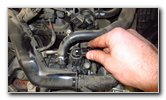 Push In New Sensor |
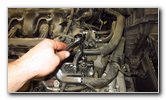 Tighten Bolt Clockwise |
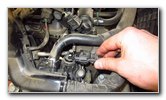 Push On Power Plug |
| Lower the new
sensor down into the engine. Rotate the new sensor back and forth a few times to help spread the oil on the rubber o-ring. Line up the bolt hole in the sensor with the corresponding bolt hole in the valve cover. Spin in the bolt a few turns by hand in the clockwise direction to help prevent it from becoming cross threaded. |
||
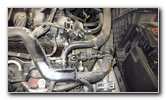 New Sensor Installed |
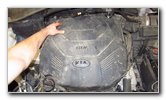 Push On Plastic Cover |
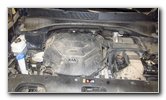 Engine Cover Secured |
| Tighten the bolt in
the clockwise direction with the 10mm socket and a 1/4" drive ratchet until
it is snug. Try to avoid over tightening the bolt to prevent from cracking the plastic sensor assembly. Lower the plastic cover back into place and push on it to secure the four rubber friction fasteners. Clear any diagnostic trouble codes with an OBDII Scanner and turn off the ignition. Start the engine and see if the new sensor has resolved the problem. Be sure to write down the sensor change in your vehicle's service records. Please
take a look at
all of my
2016-2020 Kia Sorento DIY Repair & Maintenance Guides. |
||
| If you found this guide to be helpful,
please consider making a small donation by clicking on the PayPal.com
"Donate" button located to the right of this paragraph. Thank you!
(Note: I am not a registered charity. Donations are not tax deductible.) |

